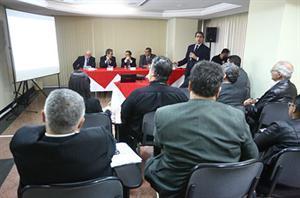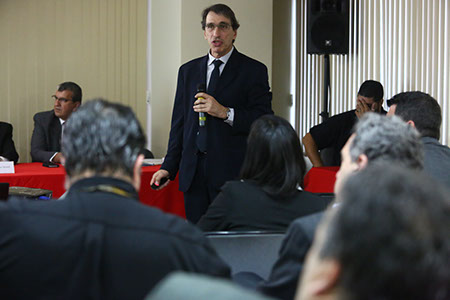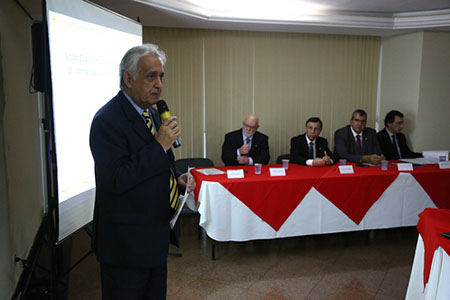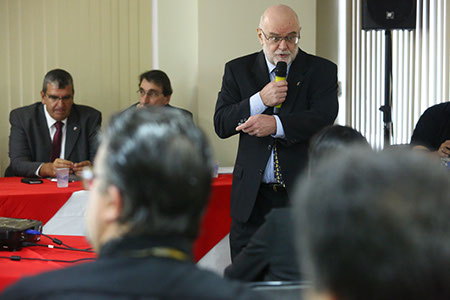Publicado em 04 de dezembro de 2012 por Mecânica de Comunicação
Sales of construction equipment expected to close 2012 with 19% drop
Decrease in sales of on-highway trucks and a slower pace in construction works were the main factors responsible for the year’s results.

Sales of equipment used in construction are expected to be 19% lower this year compared to 2011. The conclusion comes from the Sobratema Study of the Brazilian Market for Construction Equipment, prepared by Sobratema - the Brazilian Association of Technology for Equipment and Maintenance and released on Tuesday, November 13 during the launch of the Sobratema Guide to Equipment 2012-2014 - an event which had the participation of entrepreneurs, executives and professionals in the chain of construction and mining.
"This result is essentially attributable to a decline in sales of trucks due to the anticipation of truck purchases by companies in 2011 because of the changes introduced in 2012-model vehicles for compliance with new emission standards established by Proconve-7 [comparable to Euro V] which went into effect in 2012 and made new vehicles more expensive,” said Mario Humberto Marques, vice president of Sobratema. Depending on the year, on-highway trucks for the sector of construction account for 40% to 50% of the final result in sales of equipment in this segment.
In the heavy equipment line (aka the ‘yellow’ line), the drop in sales is lower and estimated at 3% in 2012 compared to last year. In 2011, this segment had logged a record high with over 30,500 units sold. For this year, expectations are that the number of machines sold will reach approximately 29,700 units.



"This decline stems from the slower pace in the execution of infrastructure works throughout the year. The projects for highways, railways, seaports and in the area of basic sanitation did not continue at the same rate as before,” explains Marques. Sales of motor graders and road rollers (roller compactors), for example, are expected to fall 27% and 30% respectively this year compared to last year. These two categories of equipment are highly used in road works.
The performance of the sector in Brazil is superior to what will be achieved in markets abroad, where sales of earthmoving equipment are expected to report a drop of 9% on the average. This shows that, despite the lower volume of equipment sold, Brazil remains a promising market.
As regards importation, which accelerated in 2011, importing of equipment slowed down throughout 2012 and logged a decline of 14% in the period from January to August of this year compared to the same period in 2011.
The Sobratema Study shows that sales of construction equipment manufactured in Brazil rise more rapidly than imports as of August 2012. The reasons: the entry into effect of a special credit policy for purchasing of machines under the government’s ‘Programa de Sustentação do Investimento’ (PSI - Program for Sustaining of Investment) managed by the BNDES - Brazil’s Development Bank, and the devaluation in the foreign exchange rate introduced at the end of the first half of the year. These data project a trend of improvement in the last months of 2012, signaling good prospects for 2013 with the possibility, even, of achieving a record in 2013 sales and growth of 13%.
To most of the manufacturers, importers and users of equipment who were interviewed in preparing the Sobratema Study, the expectations for the coming year are for growth between 5% and 20% in sales of heavy construction / earthmoving equipment (i.e. the ‘yellow’ line). Considering all categories of equipment, the projections indicate growth in the neighborhood of 12% compared to the results for this year.
The positive expectation among certain leaders in the sector is largely due to the announcement made by Brazil’s federal government in mid 2012 of a number of measures to stimulate the economy, including a program of concessions of highways, railways and other infrastructure projects to the private sector, some in the form of public-private partnerships. The study warns however that the confirmation of good prospects will depend on factors that involve the economy’s other ‘indicators’, such as progress of the economy in general, foreign exchange policy, interest and actual progress in the execution of infrastructure projects.
Projections through 2017
The Sobratema Study of the Brazilian Market for Construction Equipment also presents projections through 2017 for sales of machines, whose average annual growth will be 10.42%. Until 2014, the rate of growth will be higher due to the resumption of the government’s PAC (Program for Acceleration of Growth) and possible concessions. As of 2014, an election year, estimated average growth is expected to decline to 8% until 2017.
The Sobratema Study of the Brazilian Market for Construction Equipment has been published since 2007 and covers the main equipment in the so-called ‘yellow’ line (earthmoving and compacting equipment) plus gantries, cranes, portable compressors, aerial work platforms, telehandlers, farming tractors and trucks used by construction companies.
British journalist Brian Nicholson and Professor Rubens Sawaya of PUC-SP, economic consultants to Sobratema, contributed in the compilation and analysis of data. The Sobratema market study enables its users to gauge the economic importance of the sector and of the policies that facilitate the acquisition of modern and efficient equipment, in addition to being a useful tool for planning by the sector’s companies.

Av. Francisco Matarazzo, 404 Cj. 701/703 Água Branca - CEP 05001-000 São Paulo/SP
Telefone (11) 3662-4159
© Sobratema. A reprodução do conteúdo total ou parcial é autorizada, desde que citada a fonte. Política de privacidade


